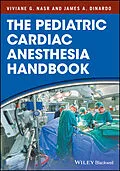Written by an expert author team at the renowned Boston Children's Hospital, USA, The Pediatric Cardiac Anesthesia Handbook provides a comprehensive yet concise overview of the anesthetic management of pediatric patients with congenital heart disease.
This book is divided into two parts. The first part provides an introduction to the basic assessment of patients, including cardiovascular physiology, pathophysiology and the underlying concepts in coronary heart disease, preoperative evaluation, intraoperative management, and interpretation of cardiac catheterization data. The second part of the book addresses disorders and diseases in a templated manner covering the anatomical and physiological features, surgical therapies, anesthetic approach and postoperative management. Chapters on the heart and heart and lung transplantation consider the additional complexities of those patients and anesthetic considerations for non-cardiac surgery after heart transplantation.
The anesthesiologist caring for patients with congenital heart disease faces a myriad of challenges in the perioperative management of these complex individuals. This book provides:
* A concise and easily referable guide ideal for use during anesthesiology residency training and fellowships.
* A templated chapter layout ideal for easy referral by wider members of the multidisciplinary team, such as cardiologists, cardiac intensivists, perfusionists, and surgeons.
* Helpful illustrations and a bulleted content for rapid reference.
* Guidelines on specific lesions for the pediatric anesthesiologist caring for cardiac patients presenting for non-cardiac surgery.
This book is a valuable resource for all anesthesiology and cardiac critical care providers who manage patients with congenital heart disease, and an ideal study aid.
Autorentext
Viviane G. Nasr, MD graduated from Medical School at the American University of Beirut (AUB), Lebanon in 2003, and pursued a residency in anesthesiology at AUB and Tufts Medical Center, Boston. She completed a pediatric anesthesia fellowship at Children's National Medical Center (CNMC) in Washington DC and a pediatric cardiac anesthesia fellowship at Boston Children's Hospital. She is American Board certified in Anesthesiology and Pediatric Anesthesiology and an active member of the Congenital Cardiac Anesthesia Society.
James A. DiNardo, MD graduated from Dartmouth College and Dartmouth Medical School (with honors). He completed his anesthesia residency and fellowship in Cardiac Anesthesia at Beth Israel Hospital in Boston. He joined faculty at Boston Children's Hospital in 1999 where he currently serves as the Chief of the Division of Cardiac Anesthesia. He spends approximately one third of this clinical time as an Attending in the Cardiac ICU.
Dr DiNardo is certified in perioperative TEE and is former Chairman of the PTEeXAM Committee. He is also a Senior Oral Board Examiner for the ABA, a member of the ABA Pediatric Examination Writing Committee, and Chair of the Pediatric MOCA Examination Committee. He is Past-President of both the Congenital Cardiac Anesthesia Society and the Association of Cardiac Anesthesiologists. He is currently the Anesthesia and Analgesia Executive Editor for Pediatric Anesthesia.
He is the author of a major textbook on cardiac anesthesia and of more than 160 peer-reviewed articles and book chapters.
Inhalt
Preface xvii
Part I The Basics 1
1 Cardiovascular Development 3
Embryology 3
Cardiovascular Physiology 3
Fetal Circulation 3
Closure of the Ductus Arteriosus 5
Closure of the Foramen Ovale 6
Closure of the Ductus Venosus 6
Pulmonary Vascular Changes 6
Myocardial Performance in the Neonate 7
Hemodynamic Changes at Birth 7
2 Important Concepts in Congenital Heart Disease 9
Pathophysiology of CHD 9
Concepts of Shunting, Single-Ventricle Physiology, and Inter-Circulatory Mixing 9
Shunting 9
Effective Blood Flow 10
Total Pulmonary Blood Flow/Total Systemic Blood Flow 10
Single-Ventricle Physiology 10
Intercirculatory Mixing 13
Classification of Anatomic Shunts 15
Simple Shunts 15
Complex Shunts 15
Pulmonary Vascular Pathophysiology 18
Causes of Pre-Capillary PH in CHD 18
Causes of Post-Capillary PH in CHD 18
Control of Pulmonary Vascular Resistance 19
PaO2 19
PaCO2 19
pH 19
Variation in Lung Volumes 19
Vasodilator Agents 20
Sympathetic Nervous System Stimulation 20
Myocardial Ischemia 21
Aortic Diastolic Pressure 21
Subendocardial Pressure 21
Heart Rate 22
Anatomic Coronary Artery Lesions 22
3 Preoperative Evaluation 23
Clinical History 23
Physical Examination 23
Associated Congenital Abnormalities 24
Laboratory Data 25
Pregnancy 26
Psychological Considerations 26
Preoperative Preparation 27
Preoperative Fluid Therapy 27
Preoperative Medications 29
4 Intraoperative Management 31
Intraoperative Monitoring 31
ECG and Blood Pressure 31
Systemic Oxygen Saturation 32
End-Tidal CO2 32
Central Venous Pressure 32
Temperature 33
Near-Infra-Red Spectroscopy 33
Transcranial Doppler 34
Transesophageal Echocardiography (TEE) 35
Airway Management 35
Anesthesia Induction and Maintenance 36
Induction of Anesthesia 36
Mask Induction 36
Intravenous Induction 36
Maintenance of Anesthesia 37
5 Interpretation of Cardiac Catheterization Data 39
Right-Heart Catheterization 39
Right Atrial Pressure (RAP) Waveform 39
Right Ventricular Pressure (RVP) Waveform 39
Pulmonary Artery Pressure (PAP) Waveform 40
Left-Heart Catheterization 40
Left Atrial Pressure (LAP) Waveform 41
Left Ventricular Pressure (LVP) Waveform 41
Aortic Pressure Waveform 41
Left Ventriculography 41
Coronary Angiography 43
Coronary Anatomy 43
Anatomic Coronary Lesions 44
Coronary Collaterals 45
Cardiac Output Determination 45
Thermodilution Technique 45
Fick Determination 45
Evaluation of Cardiac Shunts 46
Shunt Location 46
Shunt Quantification 46
Saturation Data 48
Resistances 48
Assessment of Pulmonary Vascular Anatomy 48
Evaluation of the Pulmonary Vasculature 48
Pulmonary Artery Wedge Angiogram 48
Pulmonary Vein Wedge Angiogram 49
Assessment of Pulmonary Arterial Hypertension 49
Assessment of Valve Lesions 50
Stenotic Lesions 50
Regurgitant Lesions 50
6 Cardiopulmonary Bypass 51
The Cardiopulmonary Bypass Circuit 51
Differences Between Adult and Pediatric CPB 53
CPB Flow Rates 53
Anesthesia During CPB 53
Monitoring During CPB 54
Hemodilution 54
Priming Solution 54
Ultrafiltration 55
Conventional Ultrafiltration 55
Modified Ultrafiltration 55
Blood Gas Management 55
Deep Hypothermic Circulatory Arrest and Regional Perfusion Techniques 57
Anticoagulation 57
Protamine Reversal 58
7 Mechanical Support Devices 59
Extracorporeal Membrane Oxygenation (ECMO) 59
Indications 59
Relative Contraindications 59
Modes of ECMO Support 59
Veno-Venous (VV)-ECMO 59
Veno-Arterial (VA)-ECMO 59
Device and Patient Complications 60
Common Terminology Used During an ECMO Run 61
Intraoperative Considerations for Patients on ECMO 61
Ventricular Assist Devices (VA…
